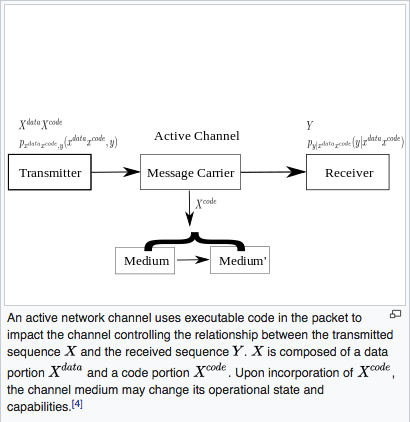接上第二点
NOTE
(2)active networks => Programmability in networks(1990s)
Sturcture:
What are active networks?
motivation for active networks
technologies behind active networks
How do active networks related to SDN?
The legacy of active networksWhat are active networks?
1.Networks where switches perform custom computations on packets.
2.Examples(and motivation)
-1.Trace program running at each router. (i.e. traceroute)
-2.Middleboxes, eg.firewalls, proxies(代理), application services. <=> custom computations on traffic, Middleboxes <=> modern-day active networks
Origins of active networks.
1.DARPA research community(1994-1995), i.e.discussing
2.Identified problems with today's networks
-1.Difficulty of integrating new technology. => it's very difficult to develop technologies on today's network.
-2.Poor performance due to redundant(冗余) operations at several protocol layers(protocol stacks)
-3.Difficulty accommodating(容纳,适应) new services.
Motivation for active networks
1.Accelerating innovations(the same as SDN)
-1.Internet innovations rely on consensus(一致)
-2.Take ten years from prototype to deployment.(standardlization => procurement(获得,i.e.生成新的设备) => deployment)
2.Active nodes allow routers to download new services into the infrastructure. => User-driven innovation
Idea: Message carry Procedures and Data

(pics from wikipedia)
1.Active routers coexist(共存) with legacy(旧的) routers.
2.Each programmable switch can perform additional processing.
User "Pulls" and Technologies "Push"
1.User Pulls(demand)
-1.Proliferation(增加) of firewalls, proxies, transcoders, etc.
-2.Goal: Replace ad hoc(which means "for this" in Latin) approaches.
2.Technologies Push(enablers) => provide services to meet the users' demands
-1.Safe excecution of mobile code, Java applets.
-2.OS Support: Scout(real-time communications), Exo_kernel(safe access to low-level resources), SPIN(trustworthy code generation) => provide better environment and services => nice support
Two different approaches to active networks
1.Capsules("integrated") => every packets carried a program => node excecute
-1.Every message is a program. Active nodes evaluate(评估) content in packets.
-2.Code dispatch(迅速处理) to excecution env.
数据报即程序,积极节点执行处理并转发。
2.Programmable Switches("discrete(分离的)") => nowadays
-1.Custom processing functions run on routers.
-2.Packets are routed through programmable nodes.
-3.Program depends on the packets headers.
节点根据数据包首部和提前写入节点的程序进行处理。like p4 nowadays.
2017/2/23







 本文介绍了激活网络的概念,探讨了其起源和发展,特别是作为解决传统网络问题的一种方式。文章还讨论了激活网络与软件定义网络(SDN)之间的联系,并回顾了激活网络的历史遗产。
本文介绍了激活网络的概念,探讨了其起源和发展,特别是作为解决传统网络问题的一种方式。文章还讨论了激活网络与软件定义网络(SDN)之间的联系,并回顾了激活网络的历史遗产。
















 883
883

 被折叠的 条评论
为什么被折叠?
被折叠的 条评论
为什么被折叠?








